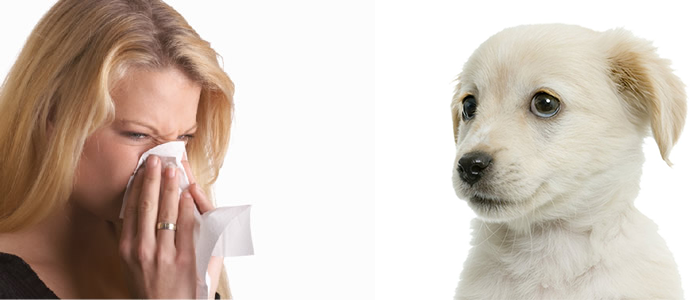Dog allergies are a fairly common source of misery for many people. Although not as common as cat allergies, many people do react to dogs as well. Allergy symptoms may include itchy, watery eyes. You may have a stuffed nose, runny nose, post nasal drip or sneezing. Some people develop a skin reaction, such as itchiness or hives. Others may experience wheezing or chest congestion.
Surprisingly, dander from the skin of dogs is not the primary source of allergens. Researchers have isolated the prime source of trouble in dog salvia. The allergen is referred to as Can f 1. Another possible allergy trigger is a protein found in the dog’s blood called albumin. On the other hand, the major source of allergies from cats is found in dander from the sebaceous glands in the skin.

Although cat allergies are far more common, dog allergies are still a major source of concern for pet owners. Surprisingly, owning a dog might actually help young children develop immunity to allergies. Animals release a protein called endotoxin, which seems to stimulate the immune system. In fact, studies have shown infants and young children who live with a dog wheeze less than babies who reside in pet-free homes. A word of caution from the experts who say that in some cases endotoxin can make allergy symptoms or asthma worse if the resident already suffers from asthma or allergies.
 If you are allergic to dogs, doctors usually recommend you avoid dogs. You may be able to take allergy medications for your symptoms. However, if you have a dog in your home, and are allergic to it, medication may not be able to control your reactions.
If you are allergic to dogs, doctors usually recommend you avoid dogs. You may be able to take allergy medications for your symptoms. However, if you have a dog in your home, and are allergic to it, medication may not be able to control your reactions.
Allergy shots are another possibility. This is known as immunotherapy. In this case, you get needles once or more every week that contain a little bit of the allergen. The extract is gradually strengthened until your body becomes desensitized. You will continue to undergo the allergy shots on a weekly, and eventually, monthly maintenance basis. It could take several years before you build up a resistance to dog allergens.
 If you already own a dog when you are diagnosed with the allergy, you may not want to let go of your pet. You can take some action to decrease your exposure to dog allergens. Apparently neutering your dog can help reduce allergy symptoms. It’s also important to bath your dog at least once a week, preferably more often. In addition, you could wipe your dog down with a damp cloth on a daily basis. You spend a lot of your time at home sleeping in your bed. so it is important to ban the dog from your bedroom. You should also close the air vents to the bedroom and keep the bedroom door shut. If possible, you may want to have the dog sleep in the garage instead.
If you already own a dog when you are diagnosed with the allergy, you may not want to let go of your pet. You can take some action to decrease your exposure to dog allergens. Apparently neutering your dog can help reduce allergy symptoms. It’s also important to bath your dog at least once a week, preferably more often. In addition, you could wipe your dog down with a damp cloth on a daily basis. You spend a lot of your time at home sleeping in your bed. so it is important to ban the dog from your bedroom. You should also close the air vents to the bedroom and keep the bedroom door shut. If possible, you may want to have the dog sleep in the garage instead.
Dog allergens are difficult to get rid of. You need to remove or thoroughly clean all carpets. Steam clean upholstered furniture and wash all of your curtains. Wash all bedding and blankets. You will need to give your home a thorough vacuuming on a regular basis. Be sure to use a vacuum cleaner with a hepa filter to capture the allergens. A home air cleaning or filtering system is also a good idea. Wipe down all hard surfaces in your home as well.
Certain dog breeds seem to trigger allergic reactions more than others. However, no dog is completely non-allergenic. This is because the allergen Can f 1 is found in saliva, while other triggers are proteins in the dog’s blood.
